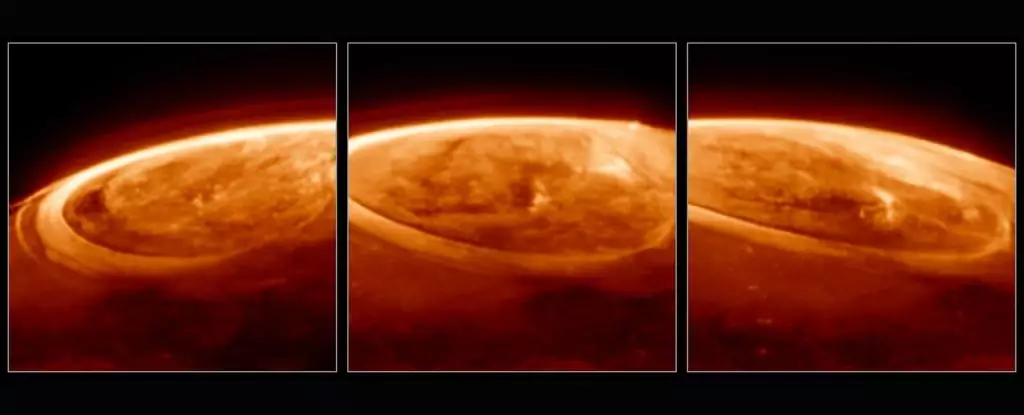Jupiter, the largest planet in our Solar System, is not just a giant ball of gas; it boasts fascinating and powerful auroras that ignite our curiosity. While Earth has its own mesmerizing auroras caused by solar activity, Jupiter’s auroras are equally remarkable and far more intense. They exist as shimmering bands of light at the planet’s poles—phenomena often invisible to the naked eye, but showcased spectacularly in non-visible wavelengths like ultraviolet and infrared. These auroras are constant dynamo-like spectacles, fundamentally linked to the planet’s extensive magnetosphere and its volcanic moon, Io.
The Role of Io in Jupiter’s Auroras
The mechanism behind Jupiter’s auroras offers a deeper understanding of these phenomena. Unlike Earth’s primarily solar-generated auroras, Jupiter’s are largely fueled by volcanic activity from its moon Io. This moon continuously emits sulfur dioxide into space, contributing to a vast donut-shaped torus around Jupiter. As Io spews out this gas, it becomes ionized and interferes with Jupiter’s magnetic field, directing high-energy particles toward the planet’s poles. Here, they collide with atmospheric particles, igniting brilliant displays of light that manifest as powerful auroras.
However, the nature of these auroras is still shrouded in mystery. Recent observations by the James Webb Space Telescope (JWST) have revealed new details about this celestial spectacle, much to the delight of scientists. As astrophysicist Jonathan Nichols noted, the observations revealed unexpected dynamics within the auroras, showcasing changes in luminosity that occurred in seconds, contrary to the prior belief that these phenomena varied over more extended periods.
The Groundbreaking Observations from JWST
On December 25, 2023, JWST provided an unprecedented glimpse into these enigmatic auroras. The findings were both enlightening and perplexing. Nichols enthusiastically stated, “What a Christmas present it was—it just blew me away!” These observations challenged preconceived notions regarding the behavior of Jovian auroras, illustrating their dynamic nature with rapid fluctuations that scientists struggled to comprehend.
Interestingly, the brightest emissions captured by the JWST didn’t correspond neatly with similar features recorded by the Hubble Space Telescope. This inconsistency has scientists questioning the fundamental dynamics at play. An unusual combination of high-energy and low-energy particles seemed to create a type of luminosity akin to a “tempest of drizzle.” Such contradictions underline the idea that much about Jupiter remains obscured, awaiting further exploration.
Unlocking the Aurora’s Secrets with Trihydrogen Ions
Another notable aspect of Jupiter’s auroras is the presence of the trihydrogen cation (H3+), a triatomic ion consisting of three hydrogen atoms. These ions can be particularly useful for studying the auroral energy budget. The JWST’s observations, combined with Hubble’s ultraviolet data, present a unique opportunity to analyze molecular behavior within these stunning displays. In doing so, scientists hope to unravel the intricate workings of the auroras and the processes that drive their remarkable features.
While the unexpected brightness observed by JWST remains difficult to interpret, it highlights the invaluable role of advanced telescopes. Such tools enhance our understanding of astrophysical phenomena that have perplexed scientists for generations. The combination of data from different telescopes can provide crucial insight into the behavior of auroras, offering a more comprehensive understanding of their formation and the energy dynamics involved.
The Path Forward: Future Research and Observations
As we continue to explore the complexities of Jupiter’s auroras, the quest for knowledge grows ever more robust. While scientists have made significant strides, many questions remain unresolved, encouraging further research. The current findings are just pieces of a much larger puzzle; how they fit into the grander schemes of planetary science will require additional modeling and observations across various wavelengths.
The beauty of studying such celestial phenomena lies in their constancy—Jupiter’s auroras are perpetual. Regardless of when we observe, there will always be something astonishing to witness. Each observation presents an opportunity to gather new data and glean further insight into the chaotic yet captivating interplay of gaseous giants like Jupiter and their astonishing auroras.
In essence, the ongoing research into Jupiter’s auroras exemplifies humanity’s relentless curiosity and dedication to understanding the universe’s curious wonders. As scientists leverage cutting-edge technology and collaborative knowledge, each discovery propels us closer to understanding the marvelous intricacies of our Solar System.

